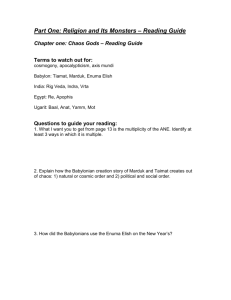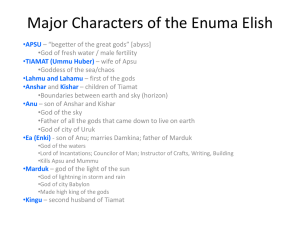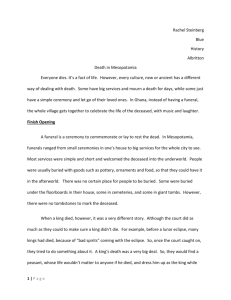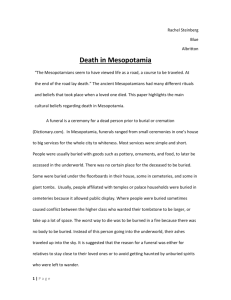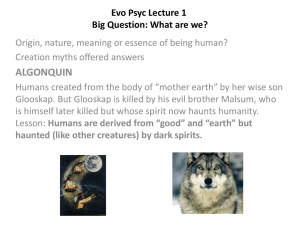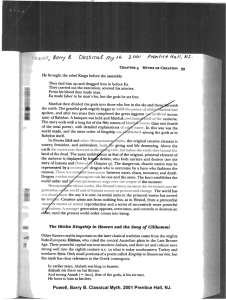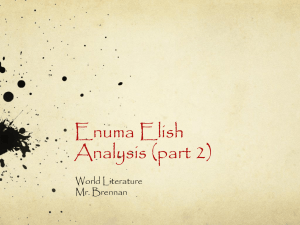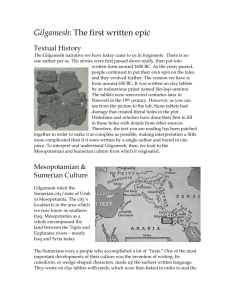Enuma Elish
advertisement
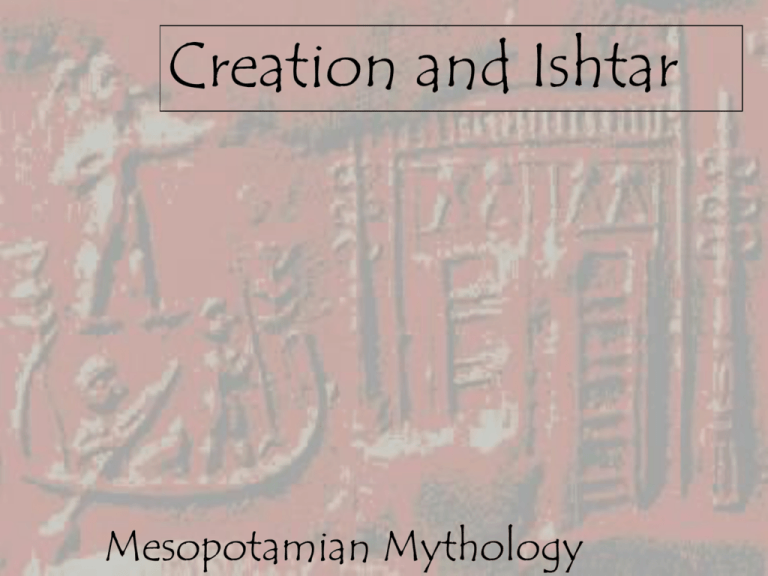
Creation and Ishtar Mesopotamian Mythology •Enuma Elish means “In the beginning •Apsu (god of primordial waters) and Tiamat (goddess of the sea) are the father and mother of the other gods •The new generations of gods are too noisy, and their noise troubles Apsu. He plots to destroy them, though Tiamat objects. •But Ea, god of sweet water, destroys him and gains authority over the gods. Enuma Elish What is Tiamat’s role so far? •Ea and his wife create Marduk. The other gods convince Tiamat to destroy the new gods. She creates a race of monsters. Enuma Elish Four were his eyes, and four were his ears; when his lips moved, fire blazed forth… [his eyes] perceived everything. Highest among the gods, his form was outstanding. •Qingu is the chief monster who assails the younger gods •Ea fails to defeat him. •Anu, an authority figure among the gods, fails to defeat him •Marduk is called upon to try. He asks for kingship of the gods in return. They agree. Enuma Elish Marduk makes his weapons and prepares for battle Enuma Elish Marduk, a storm god, encircles Tiamat with a net and blows her into pieces to defeat her. From these pieces, earth is made. He sliced her in half like a fish for drying; half of her he put up to roof the sky…[he opened up gates in her ribs … with her liver he locatedthe heights … he placed her head, heaped up … opened up springs, water gushed out … He opened the Tigris and Euphrates from her eyes, …piled up clear-cut mountains from her udder … he set up her thigh to make fast the sky; with half of her he made a rook, and fixed the earth. Then Marduk defeats Qingu. From Qingu’s blood, human beings are formed, to do all the work so the gods can be at leisure Enuma Elish Enuma Elish Marduk’s last act (of the Enuma Elish) is to have a ziggurat constructed, as a sign of human worship of the gods (and himself, as the gods’ new king). Ishtar Ishtar (Sumerian Inanna) was the city goddess of Uruk. In Sumerian tradition, she appeared in several important stories: •Story of the me (decrees which represent the key elements of Sumerian civilization)Inanna visits Enki (same as Ea) – here her father. He gets drunk, she steals the me, and thus confers power on Uruk. Ishtar In another story, she got the hero Gilgamesh to chase a demon from her hulupu tree, and make her a throne – a story which shows a good relationship between the powerful king of Uruk and the city’s patron goddess.. Ishtar and played a key role in civic cult, in a sacred marriage. She was worshipped in ornate temples . . . Ishtar Here she takes a king by the hand and leads him, a sign of divine favor. Ishtar is goddess of prostitutes but the idea that there was “sacred prostitution” at her temples is a western misreading of the evidence – blame Herodotus. But it’s possible that in a yearly sacred marriage, Ishtar’s priestess had a ritual (real or symbolic?) sexual union with the city’s king, to insure fertility for the coming year. Ishtar’s Descent Ishtar decides to visit the Underworld . . . Ishtar daughter of Sin was determined to go – to the dark house, to the house which those who enter cannot leave, where those who enter are deprived of light, where dust is their food, clay their bread . . . Ereshkigal is angry that Ishtar has come. Ishtar’s Descent What brings her here? What has incited her against me? Surely not because I eat clay for bread, drink muddy water for beer? I have to weep for young men forced to abandon their sweethearts. . . As Ishtar enters each of the underworld’s seven gates, the gatekeeper takes away an item of her high-status adornment: crown, earrings, jewelry, and finally “the proud garment of her body.” “Go in, my lady. Such are the rites of the Mistress of Earth.” Ishtar’s Descent Ishtar hangs like a corpse on a stake for three days (the Sumerian version) During this time all fertility on the earth stops. Ea sends a “pleasure boy” to the underworld who apparently performs the right action to get Ishtar released. But a substitute must be found. In the longer more complete Sumerian version, it is Dumuzi. He is taken down into the underworld to take Ishtar’s place. But he too is a fertility god (young herd animals), and cannot remain under ground forever. Apparently his sister Belili (goddess of vines) takes his place, and trades off parts of the year with him. Ishtar’s Descent •How is this story like the Greek underworld myths we have encountered (Demeter and Persephone, Orpheus, Heracles, etc.)? •How is it different? •How similar are the ideas of the underworld and its deities? •What underlying meanings are there – are they similar to the ideas about human fate you see in the Mysteries at Eleusis? finis
